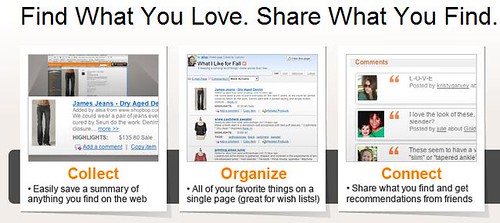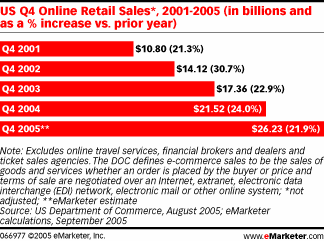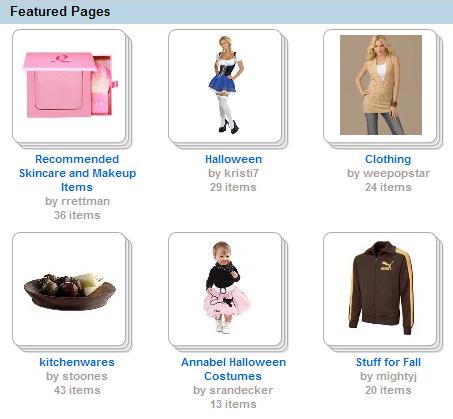From time to time, shmula interviews companies that are disruptive and value-adding, either in their approach to business, their business model, or in their technology. At bottom, these companies are doing something completely different and novel and are customer focused. To read about the companies featured on shmula, please go to the company interview page.
Be sure to read our other interviews in our leadership series.
Today on Shmula, we’re pleased to be speaking with Brian Hansen, Vice President of Product at Kaboodle. Kaboodle is one of Guy Kawasaki’s portfolio companies — that is, Kaboodle is a portfolio company of Garage Technology Ventures.
Brian, please share with us a little about your background.
I’ve been in consumer web roles for the past decade. Before Kaboodle I was Director of Product Management at MyFamily.com, COO at Infopia, and the first employee at FlipDog.com (acquired by Monster.com) where I was VP over Business Development and Product Management. Before that (when I was young) I was a Strategy Consultant at Accenture and an early employee at Onyx Software. Educationally, my MBA is from Tuck (Dartmouth) and I have a B.A. in Japanese from BYU.
What is the business problem or opportunity Kaboodle was built to solve and how does Kaboodle solve the problem?
The problem is that although it’s very common to visit several different sites (often dozens) when shopping for something, there has not been a great way to easily capture, share, and get input on the various options you consider during the process. Kaboodle solves this problem with a simple Add to Kaboodle javascript bookmarklet you click on any web page containing something you want to add to your list.
Kaboodle’s proprietary extraction technology creates a summary of that page including a picture, description, highlights (including pricing information) and a title link and puts it on a Kaboodle page. That resulting page containing all of the things on your shopping list is easy to share with friends and family to gather input. They can add comments and additional items to the same page; so collaboration is very simple no more cutting and pasting into separate emails for several people and trying to consolidate all the input that comes back.
Additionally, Kaboodle pages are public by default, so it’s also easy to reuse the work of other Kaboodlers and copy items they’ve already found across the web onto your own pages as a way to jumpstart your shopping research. We see social shopping as really the next phase in online shopping as people personalize their overall shopping experience and move from a feature and price comparison to really finding the products that fit their taste and style.

Anecdotally, 80% of the shopping activity is search and 20% is the actual purchasing — this data, I believe, mostly describes offline shopping. Do you think this data is a close approximation for online shopping behavior as well? Please elaborate and perhaps share with us a little about what the online shopper is like — demographics and the general ethnography of the online shopper.
For some online purchases, like an iTunes gift card, the process is very simple. But most online purchases have some element of personal taste or variation (like fashion, home décor, Halloween costumes, accessories, etc.) so you want to visit several sites with different offerings and pick and choose your favorites before deciding. In those types of shopping decisions, I think your 80/20 rule is pretty accurate.
A recent eMarketer report suggests that one of the big reasons consumers shop online is because prices are, on the whole, lower and there’s a wider selection. It sounds like Kaboodle was designed to help make the “selection” part easier for the customer. In that same eMarketer report, we learn that the online eCommerce space is a very large market and is growing at a healthy rate. Given this data, tell us, how does Kaboodle make money?
Kaboodle makes money through both lead generation and soon brand advertising. We currently show CPC links from Google AdSense and Shopping.com and CPA links from eBay.

With the recently-announced (in June 2006) partnership with eBay, please help us understand how that partnership helps Kaboodle, eBay, and the customer?
The MyCollectibles partnership is really about creating a place for passionate collectors who are shopping, collecting and showcasing anything they collect from coins to art pieces to pez dispensers. The collectors can connect with other collectors, discover new products and shop for them on eBay. Kaboodle benefits as it allows consumers to discover Kaboodle through eBay. eBay benefits through stronger collectibles interest and increased transactions as collectors browse collections posted by others and find items they’d like to purchase for their own collection and they typically turn to eBay to make those purchases. The customers (collectors in this case) are helped by having a free place where they can showcase their collections, connect with other collectors, and get ideas for additional items they might want to acquire next as they expand their collection. They also get entertainment value from simply browsing what other people have collected.
What are some of the best ways you’ve seen people use Kaboodle?
First, Kaboodle is the best completely open wish list available. Whether it’s your Christmas wish list, a wedding registry, your child’s birthday wish list, a baby registry, or a list of supplies you might want for your classroom if you’re a teacher, Kaboodle allows you to add items from anywhere on the web and then easily share that list with friends, family, and anyone else. Anyone viewing your wish list can reserve items so that everyone can see what’s already being purchased and what’s still needed the purchases might happen by clicking through the links on the wish list or by running down the street to your local department store; but all the coordination is managed right on the Kaboodle wish list.
Second, Kaboodle is the best way to build your personal shopping network of people with similar taste and interests who are always finding great products.
And of course Kaboodle is also ideal for managing your own personal shopping and trip planning especially group travel where several people might be helping decide on lodging, activities, where to eat, etc.

To a stay-at-home mother of 5 kids in her 30’s, how would you explain Kaboodle to her and why should she use it?
Since your question randomly happens to exactly describe my wife, I’ll just use her own words: Kaboodle saves a lot of time. Here are a few examples: It’s great to be able to put everything on a single page and then share it with grandparents who want to know what to buy for the kids’ birthdays (or for moms of the kids’ friends who are asking about birthday present possibilities). It also makes it easy to manage holiday shopping (we have private Kaboodle pages my wife and I use to keep track of what we’ve bought for the kids, notes on expected shipping arrival dates, etc. so we’re both always coordinated as we opportunistically buy things from the lists while keeping all the information hidden from the kids we copy items from the Kaboodle wish lists our kids have made as the starting point). And when we’re shopping for furniture or things for the house, it’s a great way for us both to get on the same page and narrow down the styles and specific pieces we like the pictures make it easy to quickly sit together, look at a single page, and prioritize and eliminate items.
This space seems crowded with players: ThisNext, StyleHive, Yahoo! Shoposphere, Wists, MyPickList, GiftTagging, Plum — how is Kaboodle different from the other players in this category?
The most obvious way Kaboodle differs is our powerful extraction technology. With a simple click of the Add to Kaboodle button, our engine does a lot of work behind the scenes to grab the right picture, summary, pricing information, etc. rather than requiring the user to select and annotate everything they want to capture. The second big differentiation is our discovery engine that automatically allows users to find other Kaboodle content that’s highly relevant to their current shopping search. Finally, our robust collaboration capabilities that allow multiple individuals to add items to the same page, allow for private pages with a select group of invitees, allow an option for voting on items on the page when making group decisions, and of course all the coordination logic in our wish lists for reserving gifts, seeing whether or not gifts from your own list have been reserved, etc.
Speaking of technology and software, I’d love to learn a little more about the ins-and-outs of technology at Kaboodle: there are a myriad of features in the social shopping space that one could have and, I’m sure, Kaboodle receives numerous and daily feature request from its users, in addition to features that come from your analysis of the competitive marketplace — how do you prioritize between all the possible features? Also, without sharing your secret sauce, can you share a little about the technologies behind Kaboodle — languages used, server clusters, databases, a plan for scalability?
We have a fantastic and very passionate user base who are great about sharing feature ideas with us. Since this is a new space and all of us are pioneers at this stage, real user input is extremely important. With respect to the underlying technology, we’ve built our own proprietary technology using the typical set of open source tools (java, linux, MySQL, etc.) Our engineering team has extensive experience developing highly scalable systems in their past environments; so that’s definitely a strength at Kaboodle.
Regarding brand awareness, when I do a Google search on “Kaboodle”, Kaboodle.com is returned, but so is Kaboodle.org, the open source LAN tool and Kaboodle the Linux Media Player for KDE. Have you seen namespace confusion and does it impact the Kaboodle brand?
So far, we haven’t seen any name confusion impact. We think the Kaboodle brand is very fitting since the literal meaning of caboodle is a collection of things. And recently David Placek (CEO of Lexicon Branding) mentioned Kaboodle as both a fun and a memorable name. That sentiment has been echoed by our users. We hope to be the most prominent Kaboodle and the one people think of when they think of shopping.
What can we expect next from Kaboodle?
We will continue to innovate. We are just at the beginning of redefining the shopping experience on the web. We want to facilitate better discovery, easier filters and more fun ways of making your world mobile.
Anything else you’d like to share?
Pete, thanks for talking to us. We hope your readers give Kaboodle a try this holiday season!
Become a Lean Six Sigma professional today!
Start your learning journey with Lean Six Sigma White Belt at NO COST





![[Interview] Ask Tony Hsieh, CEO of Zappos tony-hsieh-interview-pete-abilla](https://opexlearning.com/resources/wp-content/uploads/2008/11/tony-hsieh-interview-pete-abilla-150x150.png?x18631)
Leave a Reply